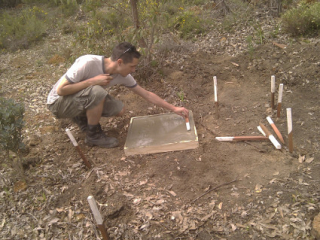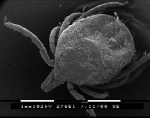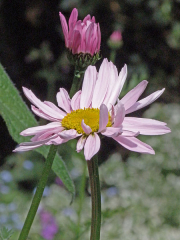The bee people at Bees Neez Apiary near Chidlow have said that the breeding program for the year is underway, and we should be able to get our baby hive by the end of October.
We’ve laid a small concrete slab for the hive to sit on (it will also have cinderblocks or similar under it to keep the wooden hive boxes well away from the termite infested ground). The hive will be surrounded by a hedgerow, which will form a bee enclosure. I’m thinking roses, bottlebrush, lavender, rosemary, apple and possibly hazelnut trees.
You see, Gallifrey has ticks. It’s unfortunate, but true. Last summer they were dreadful – by the end of summer the bloody things were dropping on us from the trees like rain or tiny, blood-sucking dropbears. We do have a management strategy, though. It’s a multi-part strategy, and with any luck in a couple’ve years it will have completely wiped out (or at least seriously diminished) the local tick population.
Phase one involves soaking some cotton wool in permethrin (a synthetic pyrethroid insecticide, similar to the pyrethrum you get from the dried flower heads of Chrysanthemum cinerariifolium and Chrysanthemum coccineum), stuffing it into cardboard tubes, and throwing those out all over the property – which we’ve done. The idea is that the mice and small mouse-like things which are the first host for the ticks take the cotton wool and line their nests with it. It kills all the ticks which try to infest their babies, so the tick life cycle is disrupted. As far as I can determine, the pemethrin is harmless to mammals – it’s used in heavy duty insect repellent sprays for humans, and apparently can cause itchy skin but nothing worse than that.
Phase two is soaking a couple’ve salt licks in the same stuff and leaving them out for the rabbits, wallabies, and kangaroos. They lick the tasty, mineral-rich salt licks and get a dose of permethrin at the same time. The animals then exude the permethrin through their pores, and thereby kill any ticks on them. Again, the tick life cycle is disrupted, and the animals bringing them onto the property stop doing that on account of being mostly tick-free. The great thing about permethrin is that it’s a powerful neurotoxin to arachnids, so the ticks die quickly and reliably, and don’t have a chance to develop immunity or resistance.
Phase three is guinea fowl. These will have to wait until we’re living there, since poultry need a bit of care and attention – and guinea fowl left without regular handling go feral very quickly. But where chickens eat approximately 80% vegetable matter to 20% insects, guineas supposedly eat 80% insects to 20% vegetable matter. And they are reputed to love ticks. Unfortunately, they also love bees. They’ve been known to sit in front of a beehive and eat every worker that comes out.
Thus we need some way of preventing the free-range guinea fowl from camping the beehives, once we have both beehives and guineas. The solution? Build a shrubbery! A nice one, sort of round, with lots of thorny, inpenetrable-to-poultry, deciduous to let the winter sun in to shine on the hive, flowering plants in it. About head height, to encourage the bees to fly above head height generally (thus having the added benefit of making the area more bee-safe for dogs and children, and people afraid of being stung). Inside this bee enclosure hedgerow will be a clear area with space for two hives, a bee keeper, and the various accoutrements of beekeeping.
Images sourced from Wikimedia Commons:
File:Teek.tif.jpg – Scanning electron microscope photo of a tick, by Kahoeben.
File: Helmeted guineafowl kruger00.jpg – by eboy
File: Pyrethrum_flower.jpg – by Amanda Slater



